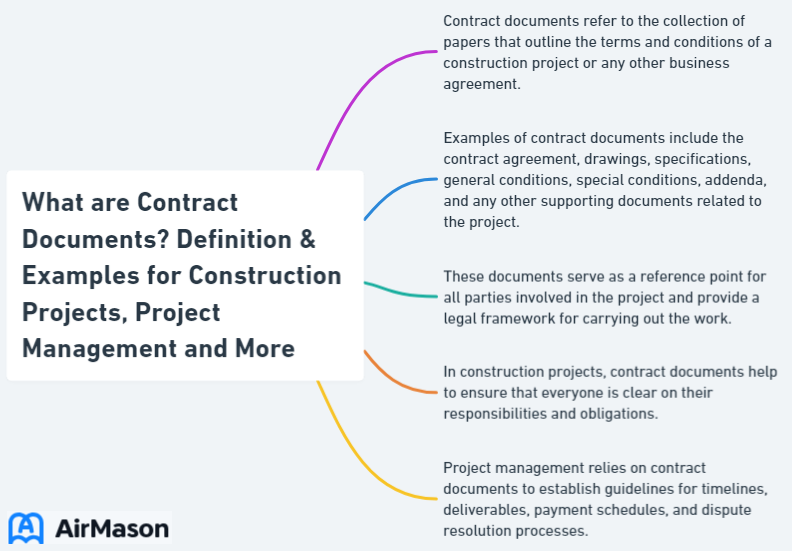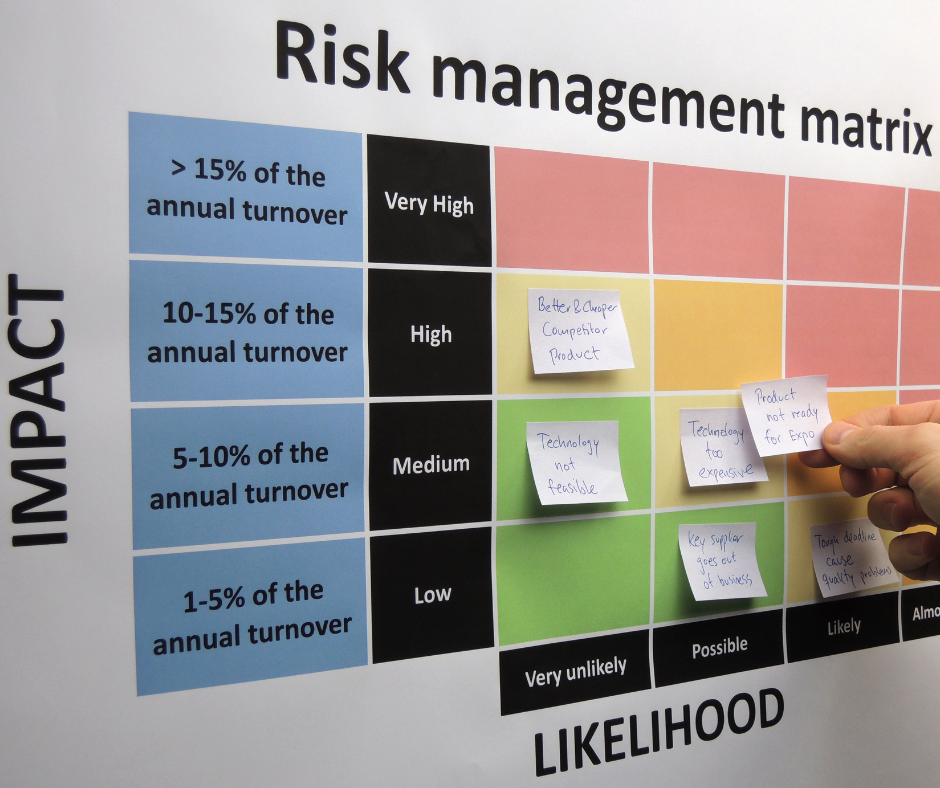
When embarking on a project or entering into an agreement, it is crucial to have a clear understanding of the terms and expectations. “What are contract documents?” you might ask. Contract documents are the backbone of any business transaction, providing the necessary framework to ensure all parties are on the same page. In this blog post, we will dive into the world of contract documents, exploring their purpose, importance, and the various types used in construction projects and project management. By the end, you will have a solid foundation to navigate and manage contract documents effectively.
Key Takeaways
- Contract documents are legally binding agreements that outline the roles, responsibilities and conditions of a project.
- Key components include parties involved, scope of work, terms & conditions and supporting documents.
- Best practices for creating & managing contract docs involve clarity/detail, collaboration/communication and document management/storage.
Contracts Definition
Contracts play a pivotal role in legal and business landscapes, with the term “contracts definition” encompassing the fundamental understanding of legally binding agreements. In essence, a contracts definition outlines the terms and conditions agreed upon by parties involved, establishing the rights and obligations each must adhere to. These agreements can range from simple transactions to complex business dealings. A clear contracts definition is crucial for mitigating disputes, as it serves as the foundation for expectations and responsibilities. Whether verbal or in writing, the essence of a contracts definition lies in creating a framework that ensures fairness and clarity in various interactions.
Understanding Contract Documents
Various industries, including construction and project management, rely heavily on contract documents. They serve as legally binding contracts that:
- Delineate the respective roles and responsibilities
- Specify the scope of work
- Stipulate the conditions
- Indicate the price
- Outline the schedule
- Provide any other job-specific information
The purpose of a contract document is to ensure all parties involved in a project are aware of their respective roles and obligations.
Including all relevant details about the project and the project team in a contract document is crucial. To avoid ambiguity or misconceptions about the accord’s stipulations among project participants, it’s necessary to be explicit and succinct when creating a contract document.

Definition of Contract Documents
A contract document serves as a legally binding agreement between parties, outlining the terms, conditions, rights, and obligations of each party involved. The contract document may include:
- The main agreement
- Drawings
- Specifications
- Schedules
- Any other materials that provide job-specific information
In construction projects, for example, a bid form is often included, which contains the contractor’s proposed price for the project, bid bond, and other relevant information.
Significance of Contract Documents
Contract documents, including construction contract documents, provide clarity in project roles and expectations, while also offering protection from potential legal issues. They often include:
- Payment terms and conditions, ensuring that all parties understand their financial obligations and that bills are paid according to the agreed-upon schedule.
- A detailed description of the work or service, such as drawings, specifications, procedures, and any other conditions, to ensure all parties have a clear understanding of the project requirements.
- Change orders and specifications that contractors must keep track of through a document management strategy.
Not implementing a document management strategy could lead to critical aspects being overlooked.
Key Components of Contract Documents

The foundation of any contract document lies in its key components. These components include:
- The parties involved
- The scope of work
- The terms and conditions
- The supporting documents
Each of these components plays a crucial role in ensuring that the legally binding contract is clear, comprehensive, and enforceable.
Grasping these components is key to successfully executing a project and minimizing potential disputes and legal issues. A clear understanding of each party’s roles, responsibilities, and obligations, as well the project’s specific requirements and expectations, enables both parties to cooperate more effectively towards the project’s successful completion.
Parties Involved
A contract typically pertains to individuals or businesses who have agreed to a legally binding agreement. The roles and responsibilities of each party involved in a contract include the promisor, the promisee, and the contractor. The legal definition of the parties involved in a contract is officially identified by utilizing functional references such as licensee, provider, lender, seller, etc., and their full legal name, registered office address, company registration number, and country of incorporation.
Accurately identifying all parties involved in a contract ensures clarity and accountability, so that each party is aware of its rights, responsibilities, and obligations.
Scope of Work
The scope of work in contract documents includes:
- Glossary
- Problem statement
- Goals of the agreement
- Objectives of the agreement
- Deliverables
- Timeline
- Milestones
- Reports
- Tasks and responsibilities
- Schedule for deliverables
A well-defined scope of work spells out the precise tasks and objectives of each contractor, making all parties aware of their contractual obligations and averting any misunderstandings or disputes.
What Does “By” Mean on a Contract
When exploring the intricacies of legal documents, understanding specific terms is crucial. “What does ‘by’ mean on a contract?” is a common question that arises. In contractual language, the term “by” typically denotes the person or entity responsible for a particular action or obligation. For instance, if a contract states that payment is due “by” a certain date, it signifies the deadline by which the payment must be made. Therefore, paying close attention to the use of “by” in a contract is essential for comprehending the allocated responsibilities and timelines within the agreement. Clarifying such language ensures a clear and accurate interpretation of contractual obligations.
Terms and Conditions
Terms and conditions are a set of stipulations that delineate the privileges, requirements, and expectations of both parties involved in an agreement. They provide protection for both parties in a contract by delineating the rights and obligations of each party.
The common terms and conditions typically found in contract documents include general conditions, special conditions, confidentiality, termination, force majeure, dispute resolution, and damages.
Supporting Documents
Supporting documents in contract documents provide supplementary information and evidence to reinforce the stipulations and conditions stated in the contract. These documents can comprise:
- Drawings
- Specifications
- Schedules
- Reports
- Other documents and pertinent materials
They assist in elucidating expectations, formalizing official agreements, documenting building elements, and safeguarding all parties involved in the contract.
Supporting documents ensure everyone has access to the same information and offer a written record of the agreement’s terms between the parties.
Types of Contract Documents in Construction Projects

In construction projects, various types of contract documents are employed to ensure a smooth and successful construction project execution. These documents serve different purposes, but they all work together to create a comprehensive and legally binding agreement between the parties involved in the project.
For project managers, contractors, and other stakeholders, it is critical to comprehend the various types of contract documents used in construction projects. With a clear grasp of the different documents and their specific roles in the project, these parties can collaborate more effectively to ensure the project’s successful completion.
Construction Agreement
The construction agreement is the foundation of a construction contract, delineating the project’s purpose, scope, and cost. It typically applies to the owner or client, the contractor, and the designer or architect.
The process for formulating a construction agreement involves the following steps:
- Determine the purpose of the contract.
- Incorporate necessary elements and clauses.
- Obtain a second opinion.
- Include a title and preamble.
General and Special Conditions
General and special conditions in construction contracts refer to a variety of operations, procedures, and indirect costs that are not directly linked to the construction itself but are still necessary for the project. General conditions typically encompass a variety of operations, procedures, and indirect costs, while special conditions are specific additions or amendments to the contract that address unique or specific requirements of the project. These conditions work together to establish the rights, obligations, and procedures for various aspects of the project.
Drawings and Technical Specifications
Drawings and technical specifications are visual and written details of the project, including materials, techniques, and quality standards. They can be found in contract documents and provide a clear understanding of the project requirements for all parties involved.
Defective specifications, however, can lead to additional costs for the contractor and potential disputes between parties.
Bill of Quantities and Schedule of Values
A bill of quantities is a comprehensive document. It contains an itemized list of all the materials, parts and labor needed for project completion. The schedule of values, on the other hand, is a document that assigns a value or cost to each work item and calculates the total value of each item based on the percentage of completion. Both documents are used for estimating and tracking project expenses and ensuring that prospective bidders can calculate their costs more precisely, ultimately leading to bills paid on time and within budget.
Contract Documents in Project Management

In the realm of project management, contract documents play a significant role in ensuring the successful execution of projects. They help establish clear expectations, roles, and responsibilities for all parties involved in the project, providing a legally binding framework that guides the project from inception to completion.
For project managers, grasping the different types of contract documents used in project management is crucial, enabling them to manage projects efficiently and curtail any risks that might surface during the project’s course.
Project Management Agreement
The project management agreement should include the following details:
- Description of the project
- Roles and responsibilities of each party
- Project timeline and milestones
- Payment terms and compensation
- Termination clauses
- Confidentiality and intellectual property rights
- Dispute resolution mechanisms
These details are essential for delineating the participants, assignments, objectives, beneficiaries, and remuneration for a project.
There are various types of project management agreements, including fixed price contracts, cost reimbursement contracts, and time and materials contracts.
Project Schedule
The project schedule is a detailed timeline of project activities, milestones, and deadlines. It is essential for all parties involved in the project to remain cognizant of the progress of the project, which can consequently minimize potential disputes and postponements.
Construction managers may utilize a variety of approaches for the development of a construction schedule, including:
- The Critical Path Method
- Gantt charts
- A line of balance
- Any other schedule that fulfills the requirements of the project.
Risk Management and Insurance

Risk management and insurance are essential components of contract documents in project management, documenting risk mitigation strategies and insurance requirements for the project. Typical risk mitigation strategies incorporated into contract documents include:
- Indemnification clauses
- Insurance requirements
- Limitation of liability clauses
- Governing law and jurisdiction clauses
- Termination clauses
- Warranty clauses
The types of insurance generally stipulated in contract documents include:
- Commercial General Liability Insurance
- Workers Compensation
- Contractors Pollution Insurance
- Builder’s Risk Insurance
- Errors and Omissions Insurance
Benefits and Challenges of Contract Documents
Contract documents offer many benefits, such as providing explicit terms, documented records, legal safeguard, and enhanced communication between parties. However, they can also present certain challenges, such as the possibility of misunderstanding, expenditure, and laborious document organization.
Despite these challenges, the benefits of utilizing contract documents far outweigh the drawbacks. Here are some of the key benefits:
- Ensuring clarity and detail in the terms and conditions of the contract
- Fostering collaboration and communication between the parties involved
- Instituting document management and storage for easy access and reference
By implementing these practices, all parties involved in a contract can work together more effectively and efficiently.
Pros of Contract Documents
Clear terms, written records, legal protection, and improved communication among parties are some of the many benefits of utilizing contract documents. These advantages help to ensure that all parties have a clear understanding of their roles and responsibilities, as well as the specific requirements and expectations of the project. This, in turn, helps to mitigate the risk of disputes, misunderstandings, and legal issues that may arise during the course of the project.
Cons of Contract Documents
Potential for confusion, cost, and time-consuming document management are some of the challenges associated with contract documents. Creating contract documents can be laborious and costly, especially if professional drafting is required. Furthermore, certain individuals may perceive them as perplexing or incomprehensible.
However, by focusing on clarity, communication, and collaboration, these challenges can be effectively mitigated, ensuring the successful execution of projects and agreements.
Contract Employment Template
When searching for the right employment solution, a well-crafted “contract employment template” can be a valuable asset. This document serves as a foundational framework, delineating the terms and conditions of the professional relationship between an employer and a contract employee. A comprehensive “contract employment template” should cover essential aspects such as job responsibilities, compensation details, and the duration of the contractual arrangement. By utilizing a thoughtfully designed “contract employment template,” both parties can ensure clarity and alignment, fostering a mutually beneficial working relationship. Whether you are an employer or a contract worker, having a solid “contract employment template” in place is crucial for navigating the complexities of temporary employment agreements.
Best Practices for Creating and Managing Contract Documents

For effective creation and management of contract documents, it is imperative to maintain clarity and detail, encourage collaboration and communication, and establish a system for document management and storage. By adhering to these best practices, all parties involved in a contract can work together more effectively, ensuring the successful execution of projects and agreements.
Adopting these best practices will help overcome the challenges tied to contract documents, guaranteeing all parties have a clear comprehension of their roles and responsibilities, along with the project’s specific requirements and expectations. This, in turn, helps to minimize the risk of disputes, misunderstandings, and legal issues that may arise during the course of the project.
Clarity and Detail
Maintaining clarity and detail in contract documents is essential to avoid ambiguity and misconceptions regarding the accord’s stipulations among project participants. This can be achieved by:
- Utilizing clear and unambiguous language in the document
- Explicitly defining the terms employed in the contract
- Providing comprehensive and particular information about the project, including scope, timelines, deliverables, and any other pertinent details.
The degree of detail in the contract ensures that all parties have a precise comprehension of their roles and responsibilities.
Collaboration and Communication
Promoting open communication and collaboration among parties during the development of contract documents is vital to prevent misunderstandings and reduce the risk of disputes or legal issues. This can be achieved by:
- Utilizing contract management software
- Devising a communication plan
- Incorporating representatives from relevant internal groups
- Communicating objectives to the other party
In addition, updates and changes to the contract documents may be required throughout the project lifecycle; effective communication ensures that all parties are informed of any modifications.
Document Management and Storage
Establishing a system for organizing, storing, and accessing contract documents is paramount to ensure they stay current and accessible. Cloud storage can be utilized for contract document management, providing a centralized and secure repository for storage, access, and management of contract documents.
Authorized personnel may access the documents from any location and at any time, thereby making collaboration and document sharing more efficient. Cloud storage additionally permits for easy version control, document tracking, and backup, thereby ensuring the integrity and security of contract documents.
Summary
In conclusion, contract documents play a vital role in various industries, including construction and project management. By understanding the different types of contract documents and their specific roles in the project, as well as the key components, benefits, and challenges associated with contract documents, all parties involved can work together more effectively to ensure the successful completion of projects and agreements. Implementing the best practices for creating and managing contract documents, such as ensuring clarity and detail, fostering collaboration and communication, and instituting document management and storage, will help to mitigate the challenges associated with contract documents and ensure a smooth and successful project execution.
Frequently Asked Questions
What are contract documents and why are they important?
Contract documents provide an accurate record of the rights and obligations of all parties involved. They also detail expectations, how they should be met, what performance is measured against, and when they need to be fulfilled. This makes them an essential element of any agreement.
What are the 5 components of the contract documents?
The five components of a contract are offer, acceptance, awareness, consideration, capacity and legality.
What type of document is a contract?
A contract is a legal document representing an agreement between two or more parties which involves an exchange of value such as money, goods, services, or space. It typically includes standard and specific business terms and may also include addenda and amendments.
Are contract documents the same as construction documents?
Contract documents and construction documents are distinct entities, with the former typically outlining details of a project prior to commencement, and the latter made up of additional documents created during the construction process.
What is the primary purpose of contract documents?
The primary purpose of contract documents is to provide a legally binding framework for all parties involved, clearly outlining each party’s respective roles and obligations.